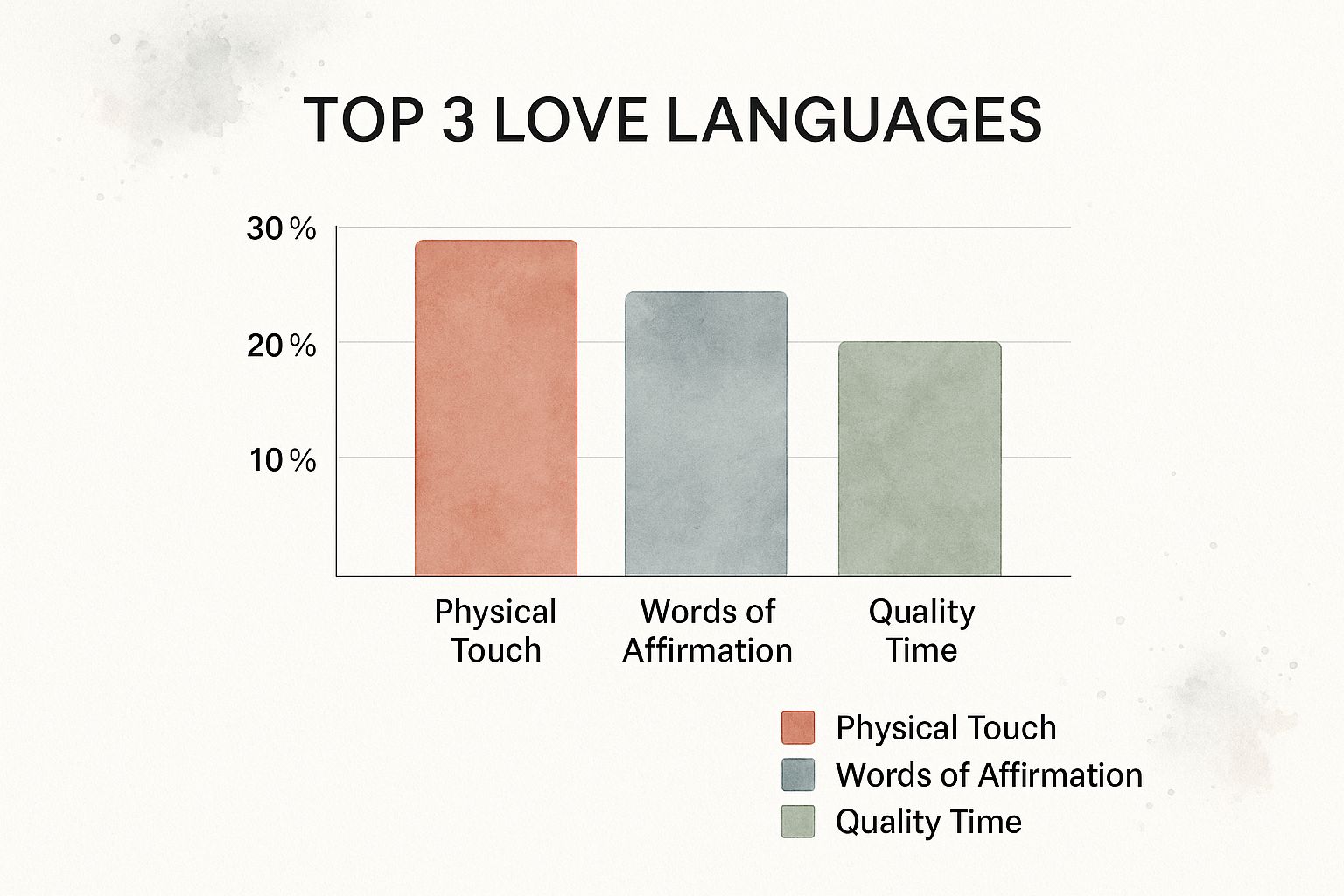Learning how to be more affectionate often boils down to one simple change: shifting your focus from grand, cinematic gestures to small, consistent acts of care. It’s about paying attention to the little moments that truly build a connection, like sharing an inside joke or bringing your partner coffee just the way they like it.
These daily "micro-mances," as I like to call them, are the real foundation of a deeply affectionate relationship.
Rethinking What Affection Really Means Today
If the idea of being more affectionate feels intimidating, you might be picturing over-the-top movie scenes instead of what connection looks like in real life. Let's clear that up. Today, showing you care is less about those huge displays and more about genuine, personalized gestures that prove you’re paying attention.
This modern approach is all about emotional vulnerability and authentic expressions, not performative romance. For many people, this reframes the goal entirely, making it feel more achievable and less like a role you have to play. It's about finding small ways to say, "I'm thinking of you," throughout the day.
The Rise of The "Micro-Mance"
The way we show love is definitely evolving. We're seeing a huge shift away from traditional romantic gestures toward what some call "micro-mance"—those small, subtle acts that build intimacy day by day.
This isn't just a hunch. Research from Bumble, which involved over 40,000 Gen Z and millennial daters, totally backs this up. An overwhelming 86% of singles now agree that showing affection is more about everyday behaviors, like sending a funny meme or a personalized playlist.
While 52% of women still identify as romantics, 37% say that a lack of these small gestures has negatively impacted their dating experiences. That tells you just how important these little moments have become.
This chart gives you a peek into which types of affectionate acts really hit home for most people.

As you can see, the data clearly shows that physical touch, verbal praise, and dedicated time together are incredibly powerful ways to express care.
What Modern Affection Looks Like
So, how do you put this into practice? Understanding how to be more affectionate starts with recognizing the opportunities in your daily routine. The best part is that these actions don't require a lot of money or planning, just thoughtfulness.
Here are a few ideas to get you started:
- Digital Connection: Send them a link to an article you know they'll find interesting. Share a song that made you think of them. It's simple but effective.
- Simple Acts of Service: Make their favorite snack after they've had a long day. Take care of a chore you know they absolutely hate doing.
- Verbal Appreciation: Be specific with your compliments. Instead of a generic "good job," try something like, "You handled that stressful call with so much patience. I was really impressed."
The way we show affection has changed, moving from big, occasional events to smaller, more frequent interactions. This table breaks down how traditional gestures have been reimagined into modern "micro-mances."
Traditional vs Modern Affection
| Gesture Type | Traditional Example | Modern Example (Micro-mance) |
|---|---|---|
| Gifting | Expensive anniversary jewelry. | Bringing home their favorite pastry just because. |
| Communication | Writing a long, formal love letter. | Sending a "thinking of you" text with a specific memory. |
| Quality Time | A fancy, planned-out date night. | Putting your phones away to talk for 30 minutes. |
| Acts of Service | A grand, home-cooked multi-course meal. | Quietly making their coffee in the morning. |
| Physical Touch | Formal dancing or a dramatic kiss. | A quick hug from behind while they do the dishes. |
Seeing these side-by-side really highlights how accessible modern affection can be. It's all about seizing the small moments that pop up every single day.
The key takeaway is that modern affection is an ongoing dialogue, not a one-time speech. It’s built through a steady stream of small, meaningful interactions that collectively say, "You matter to me every single day."
Understanding the nuances of expressive gestures can completely redefine how we view affection. Even classic acts have layers of meaning, as you can see when exploring the meaning behind giving jewelry as a present. Ultimately, every act, big or small, carries its own unique message.
Using Words to Build a Stronger Connection

Sure, "I love you" is powerful. But when it becomes the only way you express affection, those three little words can start to feel routine, like a reflex instead of a heartfelt statement. Building a stronger connection with your partner often comes down to getting more specific, personal, and consistent with your words.
It's really just about vocalizing the positive things you're already thinking about them. For a lot of people, this doesn't come naturally. It’s not because the feelings aren't there; it's just a habit that was never built. The good news? This is a skill you can absolutely learn. Starting small is the trick to making it feel genuine, not forced.
Beyond the Basic Compliment
"You look nice" is okay, but let's be honest, it doesn't exactly build deep intimacy. The compliments that truly land are the ones that are detailed and show you’re actually paying attention to who your partner is as a person. Move beyond their appearance and focus on their character, their efforts, or their unique skills.
Here’s how to level up your compliments:
- Acknowledge Their Skills: "I was so impressed with how you handled that tough conversation at work today. You were so calm and clear."
- Praise Their Character: "You have such a kind way with people. I saw how you made our waiter feel so appreciated."
- Recognize Their Effort: "I know how much work you put into planning this trip for us, and I just want you to know it means the world to me."
These kinds of statements prove that you see and value your partner for more than just what's on the surface. This is a huge piece of the puzzle, and you can dig deeper into the foundations in our guide on effective communication in relationships.
A truly great compliment makes someone feel seen for who they are, not just for what they do. It’s about validating their inner world—their thoughts, efforts, and intentions.
The Power of Expressing Gratitude
Gratitude is probably the most direct and potent form of verbal affection. When you voice your appreciation for the small, everyday things, it has a massive impact. It tells your partner, "I see you, I value you, and I don't take you for granted."
Think about all the little things your partner does that make your life even a tiny bit easier or better. The goal is to catch these moments and thank them for that specific action.
Instead of just thinking it, try saying it out loud:
- "Thank you so much for making dinner tonight. After the day I had, it really helped me unwind."
- "I really appreciate you remembering to grab my dry cleaning. You saved me a whole trip."
- "Thanks for just letting me vent about my day. It always helps to talk it through with you."
Offering Genuine Emotional Support
Being affectionate isn’t only for the good times. It's just as much about how you show up when things get tough. When your partner is struggling, your words can be an incredible source of comfort and security. Resist the urge to jump straight into problem-solving mode. More often than not, the most affectionate thing you can do is just validate their feelings and be present.
Try phrases like these:
- "That sounds incredibly frustrating. I'm so sorry you're dealing with that."
- "I'm right here with you, and we'll figure this out together."
- "Take all the time you need. I've got your back no matter what."
This kind of verbal support creates a safe space for vulnerability, which is the bedrock of a strong bond. It reinforces that you're a team, ready to face whatever comes your way. Showing you care with your words builds a partnership that’s not just affectionate, but also incredibly resilient.
Showing Affection Through Your Actions

While saying "I love you" is crucial, for many people, actions speak volumes. Demonstrating your affection through what you do gives your words weight and provides tangible proof of your feelings. It's how you show, not just tell, your partner that they are a priority in your life.
Something as simple as active listening can be one of the most profound acts of care. This means actually putting your phone down, turning away from the TV, and giving your partner your undivided attention when they need to talk. It's a powerful non-verbal cue that says, "You are the most important thing to me right now."
Master the Art of Acts of Service
Acts of service are those selfless little things you do just to make your partner's life a bit easier. The real magic happens when you tailor these gestures to what your partner actually needs or wants. It’s not just about doing a chore; it’s about doing the one that truly matters to them.
Think about it: what task does your partner absolutely dread? Is it the mountain of dishes after dinner? Folding laundry? Quietly taking on that one thing without being asked can feel like an incredible gift.
- Anticipate their needs. If you know they have a brutal week ahead at work, pack their lunch or fill up their car with gas before they have to think about it.
- Solve a small problem. Notice they're out of their favorite coffee? Grab some on your way home. It’s a small thing that shows you’re paying attention.
- Offer real support. If they're completely swamped with a project, ask, "What can I take off your plate to help you out?"
This kind of proactive kindness goes beyond just being helpful. It's a powerful form of affection that proves you're in tune with their world.
Embrace Thoughtful Physical Touch
Physical touch is a fundamental human need and one of the most direct ways to communicate affection. It doesn’t always have to be a grand, romantic gesture. Often, it's the small, consistent moments of contact that build the strongest sense of connection and security.
Of course, consent and comfort are always the top priority. Pay close attention to how your partner responds and learn what kind of touch they enjoy. A simple, gentle touch can communicate love, reassurance, and support in an instant.
Affectionate touch is scientifically proven to reduce stress. It calms the nervous system and triggers the release of oxytocin, often called the "bonding hormone." Simple acts like holding hands or a warm hug can have a measurable positive impact on both of you.
Try weaving these small moments of physical connection into your daily routine:
- A hand on their lower back as you pass by in the kitchen.
- Holding hands while you’re just watching a movie on the couch.
- A quick hug from behind while they're making coffee.
- Gently playing with their hair or giving them a foot rub after a long day.
These non-sexual touches create a foundation of intimacy and safety, making your relationship feel like a secure, loving haven. Beyond these daily moments, larger gestures and sentimental tokens of affection can also serve as powerful reminders of your feelings. Whether big or small, the principle is the same: thoughtful giving reinforces your emotional investment.
Interestingly, this drive to show care through our actions isn't just a romantic thing. A global analysis found that prosocial behaviors, like helping others, are strongly tied to affectionate interactions and overall happiness. In fact, after the pandemic, acts of kindness shot up by an average of 18% worldwide, showing just how ready we are to express care outwardly. This really highlights how action-based affection is a deeply ingrained part of being human.
Navigating Your Own Barriers to Affection

What if being more affectionate just doesn't come naturally to you? Let me tell you, that's far more common than most people realize. For a lot of us, expressing affection can feel awkward, vulnerable, or even completely foreign.
There are often deep-rooted reasons behind this discomfort. Maybe you grew up in a family where affection wasn't a big thing, or perhaps past relationships have made you hesitant to open up again. Acknowledging that these barriers exist is the first real step toward gently taking them down.
This whole process is about self-reflection, not self-criticism. The idea is to figure out what's holding you back so you can move forward with a little more intention and a lot more self-compassion.
Identifying What's Holding You Back
Before you can change a habit, you need to understand where it comes from. Carve out some quiet time for some honest-to-goodness reflection and consider what might be making affection feel so difficult.
Ask yourself a few key questions to get the ball rolling:
- Fear of Vulnerability: Does opening up emotionally just feel… risky? Past hurts have a way of making us build walls that inadvertently block intimacy.
- Past Experiences: Did your family have a more reserved emotional style? Our "affection blueprint" is often set in childhood without us even realizing it.
- Societal Pressures: Do you feel pressure to fit into a certain ideal of masculinity or femininity that discourages showing emotion?
- Attachment Style: Your ingrained patterns of relating to others play a massive role. Learning how to develop a secure attachment style can fundamentally change how you connect with people you care about.
Getting a handle on your personal history with affection gives you the context you need. It helps shift the narrative from "I'm just bad at this" to "I'm learning a new way of connecting."
Taking Gentle Steps Forward
Once you have a better sense of your internal roadblocks, you can start to challenge them with small, low-risk actions. The key here is to build comfort and confidence slowly, not to overwhelm yourself. You don't have to become a different person overnight.
Start with things that feel manageable, just a tiny bit outside your current comfort zone. For instance, if a full-on hug feels intimidating, maybe start with a brief, gentle hand on your partner's shoulder as you walk by.
The most important part of this process is open communication. A supportive partner can be your greatest ally, but they can't help if they don't understand what you're experiencing.
Have an honest conversation about your struggles and your desire to be more affectionate. You could say something like, "I really care about you, but showing it doesn't always come naturally to me. I'm working on it, and I'd love your patience while I figure it out."
This kind of talk creates a safe space for both of you. It also reinforces the idea that relationships are a place for mutual support and growth. A Pew Research Center survey found that 74% of adults would be extremely likely to turn to their partner for emotional support, which shows just how vital this role is. By being vulnerable about your journey, you invite your partner to be a part of it.
Making Affection a Daily Habit
Big, sweeping romantic gestures are great for the movies, but real, lasting change in a relationship? That’s built in the small, everyday moments. It’s all about consistency—turning tiny, intentional actions into natural habits that strengthen your bond day after day.
The goal here isn't to add another item to your never-ending to-do list. It's about weaving affection so seamlessly into the fabric of your life that it becomes second nature.
This all starts by creating simple connection rituals. We’re not talking about complicated, hour-long plans. These are small, almost sacred moments that you protect. For instance, you could start a "no phones" rule for the first 15 minutes after you both get home, giving yourselves a pocket of time to actually reconnect without the glow of a screen between you.
Create Simple Connection Rituals
One of the most powerful rituals I’ve seen work for couples is a shared end-of-day chat. You’re not just trading schedules or recapping logistics. You're talking about the actual highs and lows of your day—a moment of genuine vulnerability and support.
This simple habit transforms the generic "How was your day?" into a meaningful touchpoint for your relationship. It’s this steady stream of positive reinforcement that truly shows your partner they are a priority. If you want to dive deeper into building these kinds of routines, check out our guide on healthy relationship habits.
The trick is to make your rituals non-negotiable but super low-effort. The easier they are to stick with, the faster they become an automatic part of your day, creating a reliable source of connection even when life gets chaotic.
Your 7-Day Affection Kickstart Plan
You don't need to overhaul your entire life to build momentum. The best way to learn how to be more affectionate is by starting small with goals you can actually achieve.
Think of this simple plan as a gentle nudge—one easy action each day to get you started without feeling overwhelmed.
Use this table as a jumping-off point. Feel free to tweak the goals to fit your partner’s personality and your life together.
Sample 7-Day Affection Kickstart Plan
| Day | Simple Affectionate Goal |
|---|---|
| Monday | Send a text during the day about a specific, happy memory you share. |
| Tuesday | Put your phone away completely while your partner tells you about their day. |
| Wednesday | Handle a small chore or task you know your partner dislikes doing. |
| Thursday | Give a genuine, specific compliment about their character, not their appearance. |
| Friday | Initiate a five-minute, non-sexual cuddle session on the couch. |
| Saturday | Suggest an activity you know they love, even if it's not your favorite. |
| Sunday | Verbally express gratitude for three small things they did during the week. |
This isn’t about checking boxes off a list. It’s about exercising the muscle of intentional affection. Over time, you’ll find that these small daily actions build on each other, creating a relationship that feels more secure, connected, and deeply loving.
Answering Your Top Questions About Affection
Figuring out how to show affection in a relationship can bring up some tricky situations. It’s totally normal to have questions, especially when you’re putting in the work to build a stronger, more loving connection.
Let’s get into some of the most common worries people have when they're learning to be more affectionate. Understanding these little details is the key to making sure your loving gestures land just the way you intend them to.
What If My Partner and I Have Different Affection Needs?
This is easily one of the biggest challenges couples run into. Maybe you’re all about physical touch, but your partner lights up when they hear words of praise. This kind of mismatch in "love languages" isn't a red flag for incompatibility—far from it. It’s actually a golden opportunity to get to know each other on a much deeper level.
The first move is to have an open, honest chat about what makes each of you feel truly seen and cherished. No judgment allowed.
Ask them straight up: “When do you feel most loved by me?” Their answer might genuinely surprise you. From there, you can both make a pact to learn each other’s language. It takes a bit of conscious effort, sure, but it sends a powerful message: I care enough to love you in the way you need to be loved.
The goal here is compromise. It’s not about giving up what you need, but rather adding their needs to your toolbox. You're aiming for a healthy blend of both your preferred styles of affection.
How Can I Show Affection if I'm Not a Touchy-Feely Person?
Plenty of people just aren't wired for constant physical contact, and that is 100% okay. Physical touch is just one slice of the affection pie. If hugging, cuddling, or hand-holding feels forced or awkward, you can lean into other forms of affection that feel more natural to you.
Don’t try to be someone you’re not. Instead, focus on these powerful alternatives:
- Verbal Affirmations: Make it a habit to say what you appreciate out loud. A simple, "I was so proud of how you handled that meeting today," can mean the world.
- Acts of Service: Let your actions do the talking. Taking care of a chore they absolutely hate or making their morning coffee without being asked? That’s love in action.
The most important thing is that your affection feels genuine to you. If you force a hug you don’t feel, it’s going to come across as inauthentic anyway. Authenticity will always beat trying to fit into a mold of what you think affection should look like.
Is It Possible to Be Too Affectionate?
Yep, you can definitely be "too affectionate," but it's rarely about the amount of affection. It’s usually about a mismatch in timing or a failure to read the room and respect personal boundaries. Affection should feel like a warm, supportive hug—not a clingy, suffocating one.
Think about it this way: if your partner comes home after a ridiculously stressful day and just needs to decompress, following them around trying to initiate a cuddle session might do more harm than good.
Being truly affectionate means being tuned into what they need in that specific moment, and sometimes, that means giving them space to breathe. Pay close attention to their cues, both verbal and non-verbal. If they tense up or gently pull away, that’s your signal to ease off. A great, affectionate relationship is built on a foundation of mutual respect for each other's space and emotional state.
